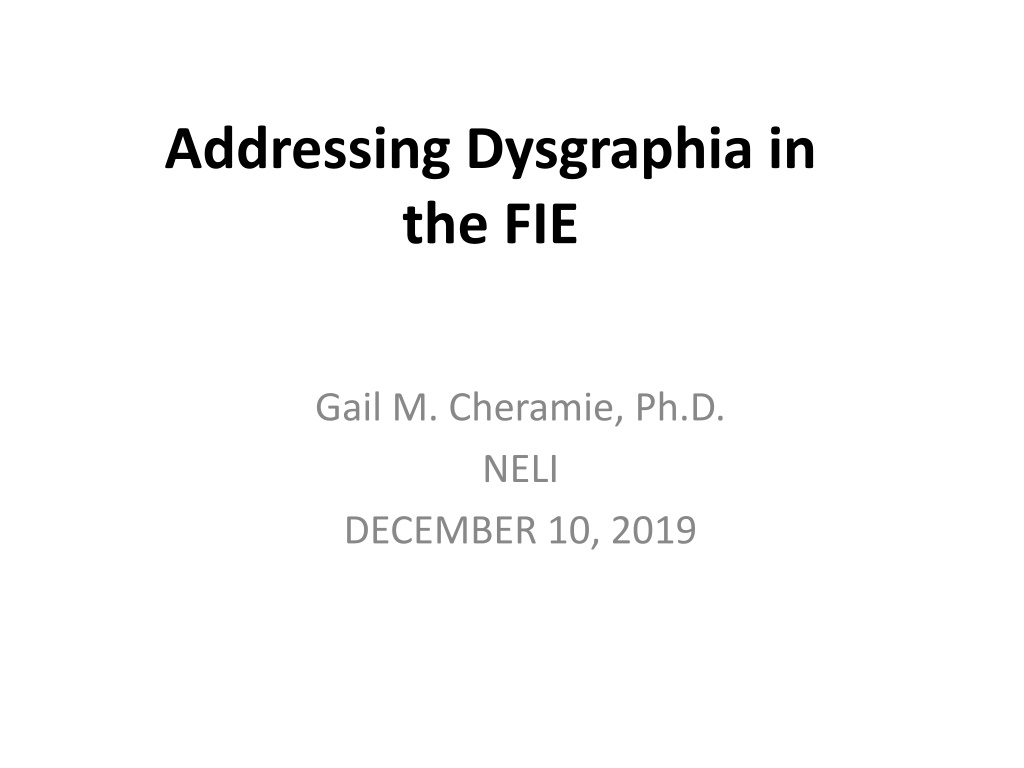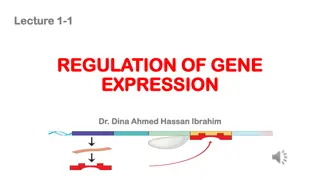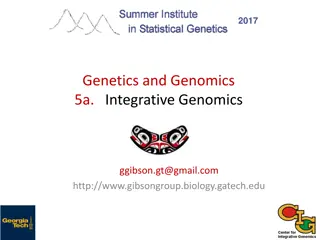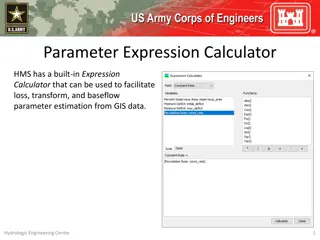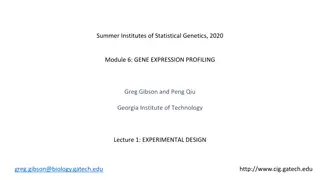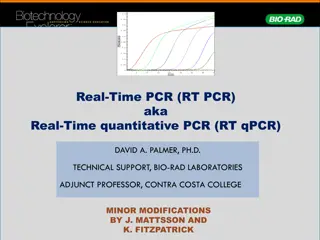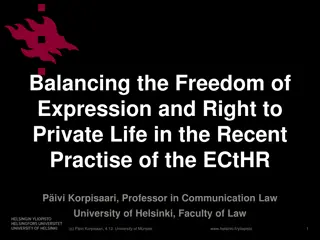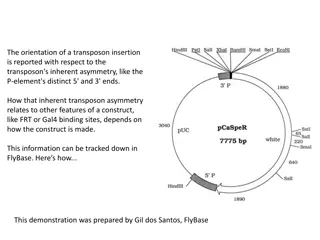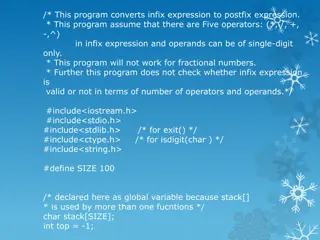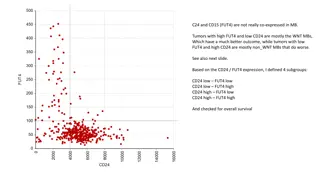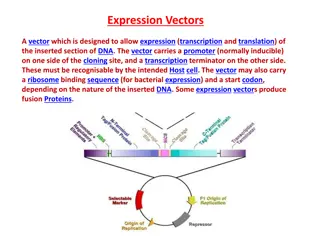Dysgraphia and Addressing Written Expression Challenges
Dysgraphia, a neurodevelopmental disorder, affects handwriting and language skills, leading to illegible and inefficient writing. Proper assessment methods and testing are necessary to address dysgraphia within the framework of specific learning disabilities. Components of written expression, cognitive processes associated with written expression, and determining LD in written expression play crucial roles in identifying and supporting individuals with dysgraphia. Additional testing, including assessing writing abilities using various methods and conditions, is essential to address the unique challenges faced by individuals with dysgraphia in educational settings.
Download Presentation

Please find below an Image/Link to download the presentation.
The content on the website is provided AS IS for your information and personal use only. It may not be sold, licensed, or shared on other websites without obtaining consent from the author. Download presentation by click this link. If you encounter any issues during the download, it is possible that the publisher has removed the file from their server.
E N D
Presentation Transcript
Addressing Dysgraphia in the FIE Gail M. Cheramie, Ph.D. NELI DECEMBER 10, 2019
Components of Written Expression Transcription handwriting, letter production, spelling Executive Functions planning, organization, monitoring, revising Text generation vocabulary, word usage, sentence and paragraph construction, amount written (production), fluency/automaticity in writing
Written Expression (WE) WE as measured by achievement instruments spelling, sentence construction, fluency, & paragraph writing Cognitive processes associated with WE: working memory linguistic processes (e.g., receptive/ expressive language, vocabulary, syntax) phonology, orthography, morphology reasoning generation of ideas automaticity
LD in Written Expression Determination should be consistent with the LD model of PSW and method (DD/C) in which: WE is the academic deficit, there are cognitive processing deficits, the cognitive and academic deficits are empirically related, the pattern occurs within a profile suggestive of adequate ability to learn, and the cognitive deficits are domain specific and the academic deficit in WE is unexpected.
WE and Dysgraphia To address Dysgraphia within the context of the FIE addressing LD, additional testing will be required Writing abilities need to be assessed using different methods (e.g., copying, dictation, constructing a written product given certain directions like a vocabulary word, picture, ) and under different conditions (e.g., timed, untimed) p. 59 of Dyslexia Handbook (2018 Update): dysgraphia is a written language disorder involves not only motor skills but also language skills
Dysgraphia Dyslexia Handbook 2018 Update, p. 59: A review of recent evidence indicates that dysgraphia is best defined as a neurodevelopmental disorder manifested by illegible and/or inefficient handwriting due to difficulty with letter formation. This difficulty is the result of deficits in graphomotor function (hand movements used for writing) and/or storing and retrieving orthographic codes (letter forms).
Dyslexia Handbook 2018 Update Chapter V p. 60
Skills & Processes to be assessed in Dysgraphia Skills Letter formation Handwriting Word/sentence dictation (timed and untimed) Copying of text Written Expression Writing fluency (both accuracy and fluency) Processes Memory for letter or symbol sequences (orthographic processing)
Dysgraphia TEA, Dyslexia Handbook, 2018 Update, Chapter V, p. 64
Instruments for Dysgraphia Many skills will be measured informally through writing checklists, writing screeners and rubrics assigned to various types of writing samples Formal Instruments for Written Expression would typically include: KTEA-3, WIAT-III, WJ-IV ACH, TOWL-4 Formal Instruments for Orthographic Processing would typically include: PAL-II, TOC, FAR Specific test of spelling: Test of Written Spelling (TWS) Most common visual-motor tests: Beery VMI, DTVP
Instruments for Dysgraphia Formal measures for handwriting legibility and speed may include: PAL-II DeCoste Writing Protocol Test of Handwriting Skills-R Children s Handwriting Evaluation Scale Evaluation Tool of Children s Handwriting
Some Characteristics of Dysgraphia- Handwriting Poor letter formation (e.g., incomplete) Illegibility Writing Speed (slow, variable, could be too fast) Mixture of upper and lower case letters within words Spelling errors Poor letter anchoring on lines (floating, swimming) Misuse of space between words and letters Too much or too little pressure Handwriting fatigue (written product may get worse as it progresses)
EXAMPLE SENTENCE COPY: Please look at this sentence. (Point to sentence on student page.) Copy the sentence in your best handwriting when I say go. If you finish before I tell you to stop, start over and write the sentence again. (Say go & start timer.) The quick brown fox jumps over the lazy dog.
EXAMPLE SENTENCE DICTATION: Listen to the following sentence. I will say it two times. Now repeat the sentence. (If student is unable to repeat sentence, repeat sentence or dictate sentence in two phrases.) Write the sentence using your best handwriting. You may write in print or cursive, whatever you prefer.
Written Productivity Access at: www.montgomeryschoolsmd.org/departments/ hiat Handwriting is assessed using 4 tasks: a task that typically requires little working memory, and no spelling or composing. The second task adds near point copying as a variable. The third task adds spelling, and the fourth task requires more working memory to compose and spell.
Case Study: ELMER NELI December, 2019
Elmer 5th Grade; Age: 10-9 DOB: 12/15/2008; DOE: 9/25/2019 Monolingual, English Passed Reading and Math STAAR in 3rd grade. Failed Reading and Writing in 4th Grade. Passed Math. Passed all academic subjects in grades 1-3. Grade 4, obtained a 65 in Language Arts. Other data were collected in this evaluation, but this case example focuses on the data related to Elmer s writing difficulties.
Parent Teacher Elmer sweet caring child Outgoing, social No discipline problems except related to homework No behavior problems; has many friends Cooperative, Respectful of authority Can have good conversations on events Told examiner he is popular and has 100 followers on Instagram Did better in 1st-3rd grades but struggled in 4th grade Academics poor, especially writing. Work avoidance for writing. Attention good. Participates in class. Favorite subjects Math and Science No problems with self- control, impulsivity or attention Good memory which is how he acquires information since his reading is below average and he cannot spell or write Enjoys baseball, riding his bike and playing video games No developmental or medical issues. Wants to be a baseball player or architect when he grows up
COG Results WISC-V FSIQ=73 VCI=74 (SI=5, VO=6); CELF-5 FormSent=6, SentAssem=3 VSI=100 (BD=9, VP=11) FRI=97 (MR=8, FW=11) PSI=66 (CD=3, SS=5) WMI=88 (DS=9, PS=7) WJ-IV COG Glr=90 (SR=98, VAL=85) WJ-IV OL Phon Awar=94 (SB=100, SEG=90) Beery VMI: VMI=85, VP=109, MotCoord=78 FAR Orthographical Processing=65
COGNITIVE PROCESSES Ga: Phonological Awareness Gc: Crystallized Knowledge Orthographical Processing Glr: Long-Term Retrieval Gsm: Working Memory Gv: Visual Processing Gs: Processing Speed Gf: Fluid Intelligence ORAL LANGUAGE
ACH Results: WJ-IV Basic Reading=88 (LWID=84, WA=106) Passage Comp=95 Calculation=93 Applied Prob=108 Broad Written Lang=67 Sent Writ Flu=81, Writ Samp=67, Spelling=77 Written Expression=70 (SWF, WS)
ACHIEVEMENT Broad Written Language Passage Comprehension Math Problem Solving Math Calculation Basic Reading
Error analysis on WJ-IV WritLang Sent Writ Flu = used the 3 words, but slow in writing and on several sentences left out important words Writing Samples = lacked elaboration in the sentence and displayed difficulty with syntax (e.g. the beilte in the closet lost) Spelling = errors in vowel combinations (e.g., rain=ran, floor=flour)
Alphabet Fluency Writing the Alphabet: Elmer began with a lower case a which was not legible, and then shifted to all upper case. Wrote 33 letters in 60 seconds. First H was not legible and looked like A; there was an overlap of the O on the N. If all letters are counted, then words per minute is 6.6. If only legible letters are counted, then 6.0 words per minute. (2nd grade level) Letters were poorly formed, but legible and often went above or below the line. Some were crowded with minimal space between them, but remained legible as independent letters (except the N and O overlap noted above). Task was repeated emphasizing that only lower case letters can be produced. All were legible, but Elmer wrote slowly to form these letters and only wrote 22 letters. (4.4 wpm 1st grade level). The last 3 letters were t, u and v. The t extended below the line, the u and v were positioned above the line, and the v was tilted.
Sentence Copy Fluency Copied the sentence: The quick brown fox jumps over the lazy dog. 8 words in the sentence were copied in the 60 seconds. A miscue was made on the o in over, and Elmer started that word again. The z in lazy was incomplete. However, all words in the sentence were legible. Therefore, on a copying task, Elmer was able to produce 32 letters in 60 seconds which is 6.4 wpm. (2nd grade level)
Sentence and Word Dictation Timed Elmer was read a list of 10 words provided by his teacher; these were words he was known to be able to spell correctly. He wrote 6 words consisting cumulatively of 28 letters. The words were spelled correctly and legible. (5.6 wpm; 1st grade level) Elmer was read a sentence from his reading book (A calm sea can turn dark and stormy without much warning.) He was able to write the first 8 words in the 60-second time limit; there were 5 legible and correctly spelled words (A, can, turn, dark, and). The wpm based on # of letters written (24) / 5 = 4.8 (1st grade level).
Conclusions Does Elmer meet the criteria for LD in Written Expression? Does he meet the criteria for Dysgraphia?
